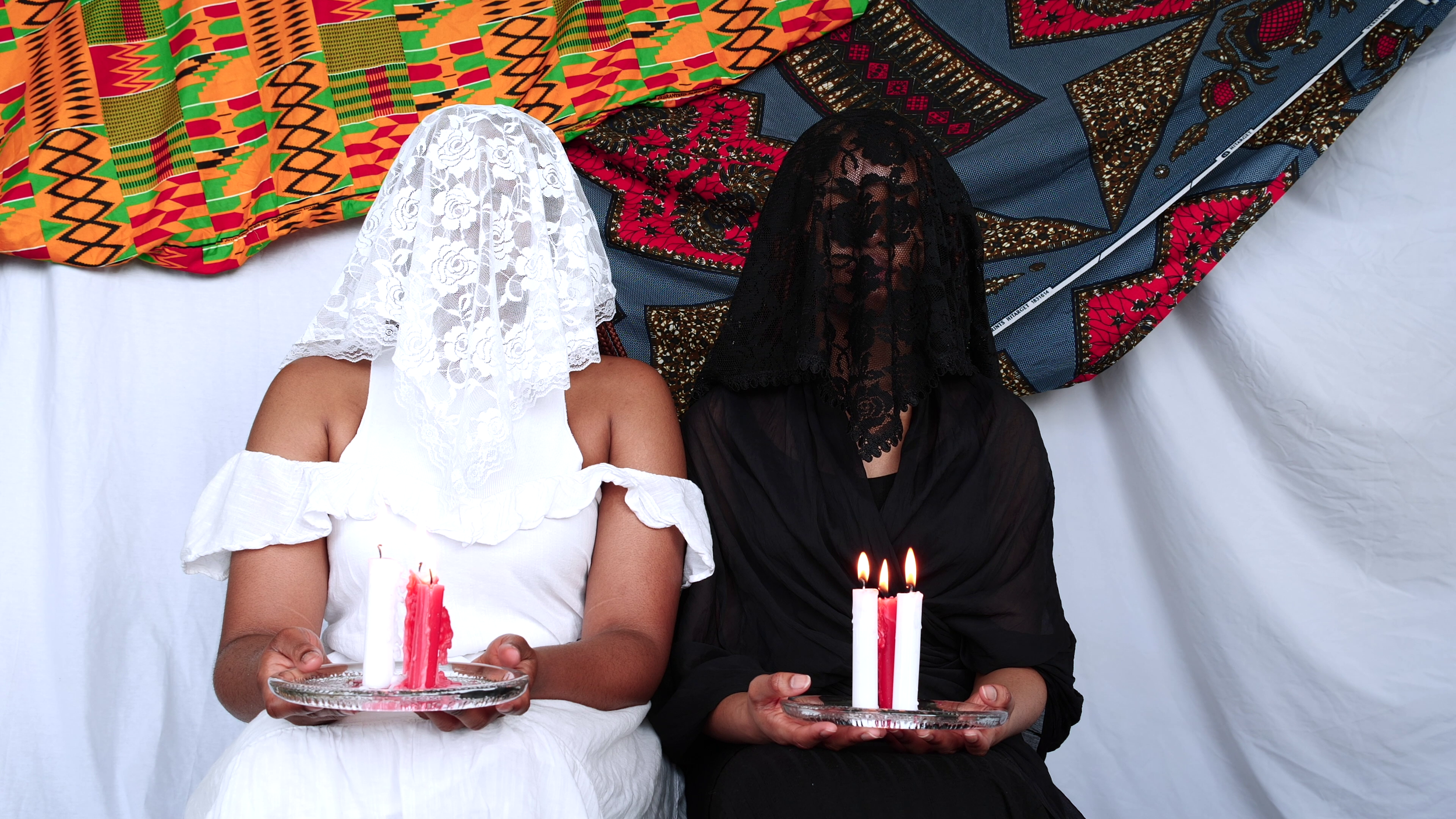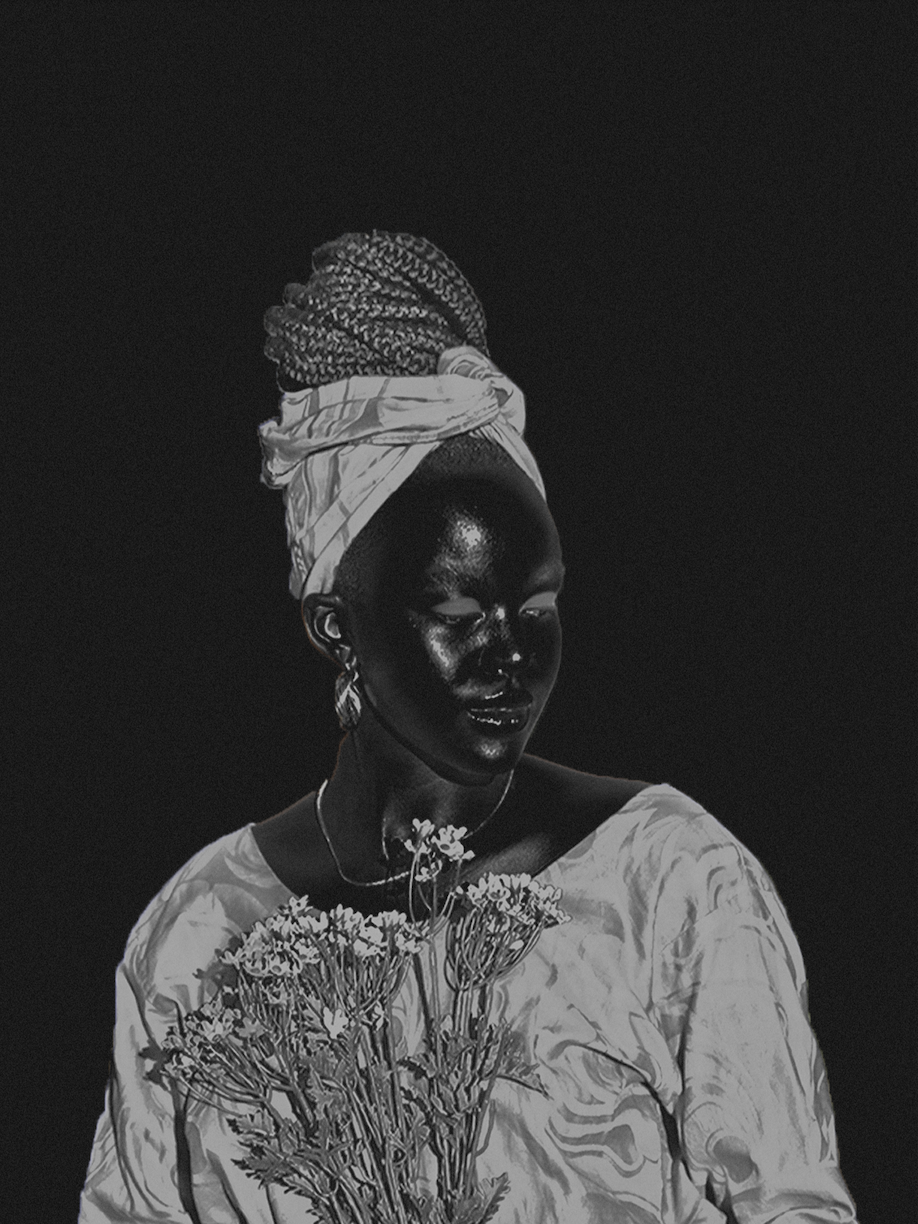New Black Arts Centre exhibitions explore the nuances of Blackness
Concealed Cultures: Visualizing the Black Vernacular and I see; I breathe; I am! at Surrey Art Gallery speak to the Black experience in the West
Sola Olowo Ake, still from Ahọn Dudu.
Surrey Art Gallery presents Concealed Cultures: Visualizing the Black Vernacular and I see; I breathe; I am!, curated by The Black Arts Centre, from September 17 to December 11; opening reception is on September 17 at 6:30 pm. Admission is free
SOLA OLOWO AKE, whose full name is Olúwáṣọlá Kẹ́hìndé Olówó-Aké, is a storyteller. The locally based Nigerian artist, who was born in Lagos State and is a member of the Yorùbá ethnic group, shares tales not only through words but also via dance, song, clothing, poetry, and film. The story Ake tells in Ahọn Dudu is about some of her experiences related to racism in Vancouver, a depiction of barriers she has encountered here. Unfolding in a narrated film that features garments and song, it is among a range of works that will be featured in I see; I breathe; I am!. The exhibition is one of two—along with Concealed Cultures: Visualizing the Black Vernacular—curated by The Black Arts Centre at Surrey Art Gallery this fall.
Working on Ahọn Dudu has already proved transformative for Ake, a graduate of Emily Carr University, where she earned her master’s degree of interdisciplinary design. Ahọn Dudu is both her, a character in the story, and a representation of her Yorùbá identity.
“This exhibition is important because even in preparing for it, I have been reminded about the nuances of Blackness,”Ake tells Stir. “Actively working to exhibit work under the umbrella of this topic has really made me more appreciative of my Yorùbá identity. It is important that people who come to this exhibition see this and not just see it to be aware but see it to know deeply that there are layers to this skin.
“The story takes on the form of a Yorùbá folktale, and it is a documentation of my experiences with barriers to Black communal development in the environment I was in,” Ake notes. “It’s recent, and it’s a reflection of the Vancouver environment at large also. Through the stories, I hope and can almost imagine that people can get a sense of some of the problems that exist in this place for Black folk.”
The vividly coloured garments in the film, Ake says, are visual representations of her personal encounters.
“In telling my story, I'm keeping my experiences alive so that people know,” Ake says. “I hope visitors take the time to really listen and reflect on my experiences in this place even if it may not be their own experience. And for the visitors that come in and have had similar experiences as me, I hope they feel seen and heard.
“I also want people to really embrace Yorùbá storytelling,” she adds. “There's a lot of singing and chanting in my work, and these songs are highlights of each of the stories, and they lead you to the heart of what Ahọn Dudu is saying.”
The creative team behind I see; I breathe; I am! and Concealed Cultures: Visualizing the Black Vernacular set out to illustrate the multifaceted nature of the Black body and the Black experience. Combined, the shows consist of works spanning sculpture to photography to site-specific installations by nine artists from across Canada, some of whom are established, some of whom just left art school, and some who don’t have any formal art education or training. Lead curator Olumoroti George explains that the companion shows are meant to be expansive—just as “making meaning of Blackness is an expansive task that will continue beyond the gallery walls”, George tells Stir.
A cofounder of The Black Arts Centre, a Black youth-owned and -operated artist-run organization and community space in Surrey, George moved to Vancouver from Lagos in 2018. It was while he was enrolled in a course at SFU’s School for the Contemporary Arts that he began deeply contemplating the Black experience in the West. He was studying curatorial and contemporary art studies, and a class about invisible cultures sparked the exhibitions’ genesis.
“I found the invisibility surrounding the nuances of Blackness to be quite strange, especially considering that amongst people in my age group, Black culture seems to be very hyper-visible and present in mainstream culture,” George tells Stir. “This has been the case for a while; due to social-media apps, Black culture has become mainstream, yet the ways that Blackness is interacted with on these apps and on a day-to-day basis still show a lack of proper education of what it means to be Black and the history of the Black diasporic struggle.”
George, who is also programming coordinator at Gallery Gachet, says he was inspired by scholar Fred Moten's theory of the great refusal. He says he connected this premise to the overarching theme of language that Jordan Strom, Surrey Art Gallery curator of exhibitions and collections, gave him as a prompt for Concealed Cultures.
“I tied language to the great refusal by using the Black vernacular as a landing point,” explains George, whose co-curators include The Black Arts Centre’s Arshi Chadha and Vanessa Fajemisin. “I believe that language amongst Black people presents itself in various ways; therefore, the actual experience of Blackness presents itself in various ways. According to Moten, Black people in the contemporary world are put in a position where they can constantly reinvent themselves to resist the exploitation of capitalist powers. This presents itself in this exhibition as the different artists are speaking specifically about different aspects of Blackness and their lived experiences as Black bodies in different ways.”
Ogheneofegor Obuwoma, still from In memory of who we were.
Ogheneofegor Obuwoma will share In memory of who we were as part of Concealed Cultures. The artist’s experiences in a Nigerian boarding school inspired the film.
“The feelings of endless time and confinement from the pandemic gave me a lot of time and moments to contemplate the relationship I have with religious institutions, my body, identity, and reality,” Obuwoma tells Stir. “The hope that someone else who went through the same things I did would relate to it is at the heart of making my film. It was a film made in hopes someone would also hear and speak the same language I speak….I appreciate the fantastic opportunity for us to present expansive ways of being, creating, and the artistic language we use to express ourselves. It’s important to me, as people don’t always acknowledge the depth and varied experience of Black people, especially across the diaspora. What we can’t speak, we can make art about that other Black people can nod their heads at and feel.”
Other artists featured in Concealed Cultures are Oluseye, Karice Mitchell, Clancy A.F Ngbolah, Odera Igbokwe, Michele Bygodt, and Nura Ali.
Nancy Ainomugisha, An Ode To my Mother.
I see; I breathe; I am!—which also features work by Nancy Ainomugisha—builds on the themes of Concealed Cultures by focusing on Black female identity “and what it means to be a Black woman in western societies when one initially thought of themselves as an African woman before they became situated in the diaspora”, George says. “I see; I breathe; I am! attempts to make meaning of Blackness but also aims to critique the term ‘Black’ from an African perspective by building on themes of female agency, community, decolonization, and divine feminine rage.”
At their core, the exhibitions are about identity—and, George says, about the politics of being asked to perform one’s identity based on assumptions. “I would like the visitors of this exhibition to not only reassess their relationships and interactions with the Black body and their relationships with themselves but also aim to explore the different aspects and multiplicity that exist in their embodiments,” George says. “I also invite the Black visitors of this exhibition to observe and reject a history of divisiveness, to realize that their ambitions, joy, and self are radically political, and to always root for themselves and their community.”
At the September 17 opening reception, George will facilitate a panel conversation with Ake, Bygodt, and Igbokwe. Other free events are happening throughout the exhibitions’ run. On October 8, members of The Black Arts Centre will be at Surrey Art Gallery for an art performance and screening of Obuwoma’s films, alongside a performance by Chipo Chipaziwa and a conversation with George and both artists. On November 12, The Black Arts Centre’s curators will lead an interactive workshop on creation in spoken form, including poetry, rap, song, and literature. The thematic focus will be on visualizing Blackness.
For Ake, Ahọn Dudu and her art practice in general are ways for her to express her belief in Imago Dei, the concept that every human being was made with dignity and that all human beings are deserving of respect.
“Sadly, racism, colonization, and many more things you can think about have done some hard work in the opposite direction,” Ake says. “I really want people to come to this exhibition and witness the greatness that exists here. I want them to leave seeing different and thinking different, and for the Black souls that come, [to be] collectively reminded that we have dignity.”
















